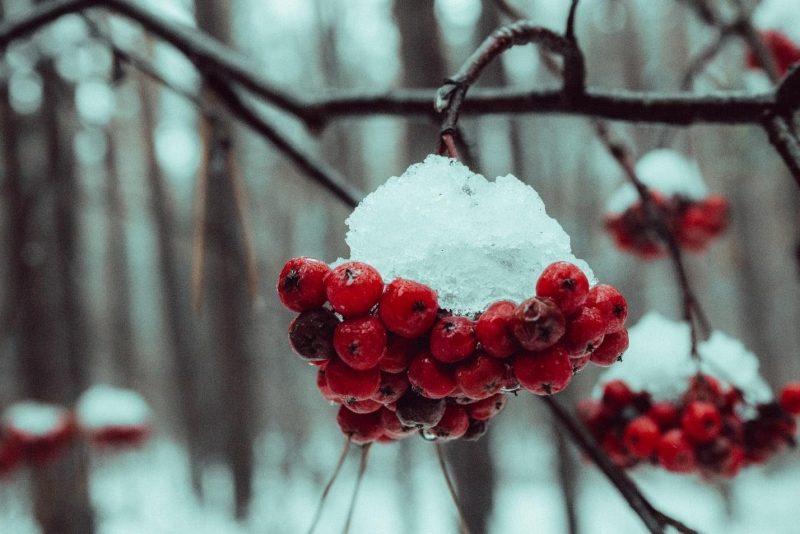The cold winter months are not generally known for their dazzling color. Between steel grey skies and blanket of white snow, the world can become uninspiringly monochromatic.
There are a number of trees that you can add to your green space to spruce up the color dial, while also improving air quality. Planting these trees on your property will take your landscape to a whole new level of amazing.
Adding deer fences keeps the tender bark safe from being ravaged by foraging deer. During the fall and winter, they are inclined to rub their antlers on it, and eat the buds and stems from the trees, both of which can cause extensive damage.
Table of Contents
Paperbark Cherry
Also known as birch bark cherry and Tibetan cherry, this tree grows best in hardiness zones 5-8. Native to Korea, Japan, and China, it is best known for its dazzling coppery “skin” under bark that sheds all year round.
The glistening copper provides delightful winter interest, unfortunately, the fragility of the tree shedding its bark makes it relatively short lived and prone to disease. However, with the protection of deer fencing, you’ll give it a chance to grow gracefully and be the star of your winter landscape.
Redtwig Dogwood
These trees offer gorgeous bright red branches, and the shrub variety can be a beautiful addition to the spring and summer landscape.
Also known as Red-Twig dogwood, Tatarian dogwood and red osier dogwood, they grow 6-9’ tall in hardiness zones 3-8. They require a moist, fertile soil and full sun to partial shade. The youngest branches are the reddest, so cut two-year-old stems for full, bright color.
Coral Bark Japanese Maple
A truly lovely tree for any season, during the winter, twigs and branches are a dazzling coral red, which is in perfect contrast to the tree’s green shades in its trunk. As the branches age, they reflect a more brownish-green hue, so cutting them back to help reveal the red of the younger branches will brighten your winter green space.
Japanese Maple
Ranging between 8 and 30 feet (both tall and wide), this tree provides phenomenal winter color that will stand out magnificently among a pale, washed out winter landscape.
Grown in hardiness zones 5-8, excessive heat will have an effect on leaf color, causing leaves to go green instead of brilliant red or purple. These trees can be planted in spring or fall and require a location that is protected from spring frosts and heavy wind.
Holly Bush
Well known and recognized at holiday time, holly bushes provide an alluring pop of color with their red berries and deep green leaves.
There are over 480 evergreen and deciduous species within the holly bush genus, and they can be found in temperate as well as tropical locations. Berries and fruits range in color from pink, black, red, yellow, and white.
Snowdrift Crabapple
Want to attract a variety of birds this winter? After all, winter birds are another superb way to add color to an otherwise bleak landscape.
The snowdrift crabapple produces rich orange fruits that attract birds, and over the course of the rest of the year they burst with pink, yellow or white flowers to make a spectacular tree for any season. They are disease resistant and are a wonderful addition to any garden or landscape.
Emerald Arborvitae
Also called ‘smaragd’ (because of its Dutch origins), these trees are often clustered together to create a natural boundary. Pyramid in shape, they can grow 3-4 wide and up to 15 feet tall. They provide a stunning green elegance to any yard and a stark contrast against a pasty winter landscape.
They maintain their color and shape year-round, and can easily tolerate insects, disease, and drought. Grown in hardiness zones 2-8, they require full sun to partial shade and have a life span of about 25 years.
Wichita Blue Juniper
The bright, silvery blue foliage on this evergreen makes for the perfect background plant, hedge or wind screen. It keeps its brilliant hue all year round, creating a soft, lush, yet vibrant focal point of color intensity during cold winter months.
Branches flare outward, and the tree can grow up to 20’ tall. Planted in hardiness zones 3-7, it can withstand temperatures that plummet to -40 degrees Fahrenheit and grow at a max elevation of 8,500 feet.
Although winter might seem like it lacks color or interest, there are a variety of plants and trees that provide incredible aesthetic appeal. Protecting these important winter players with deer fence will help them establish their root system and grow to enjoy maximum robustness.






